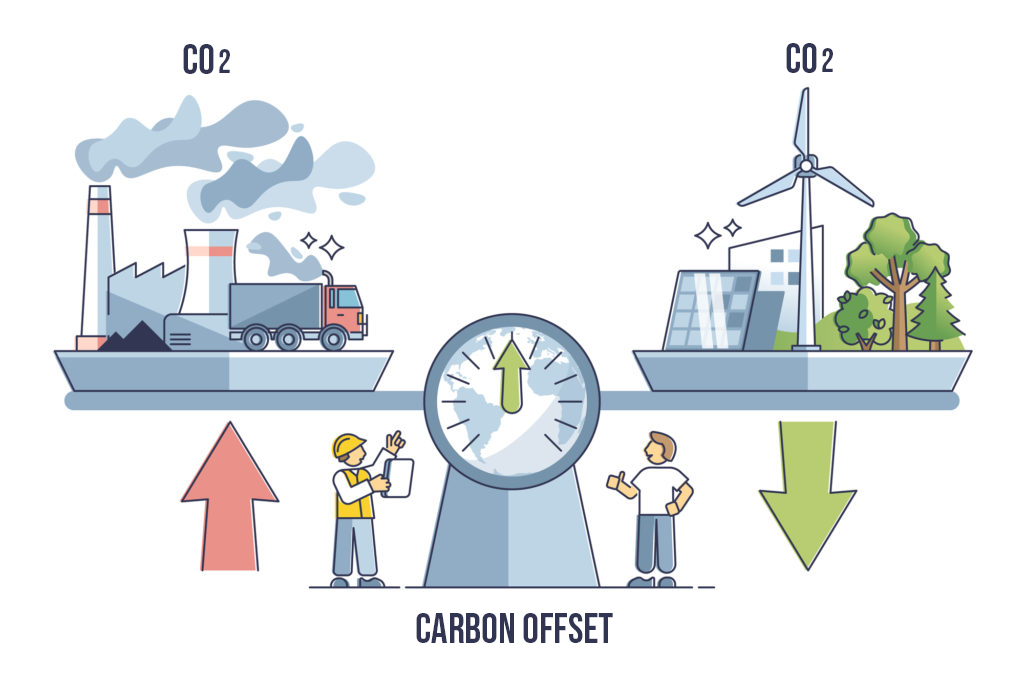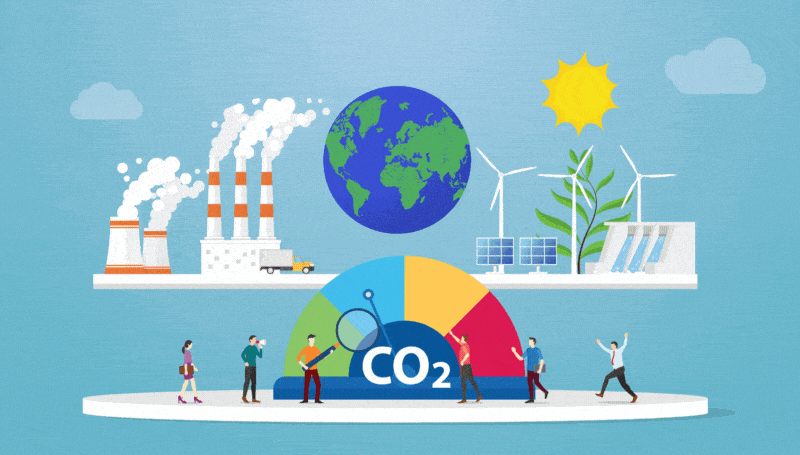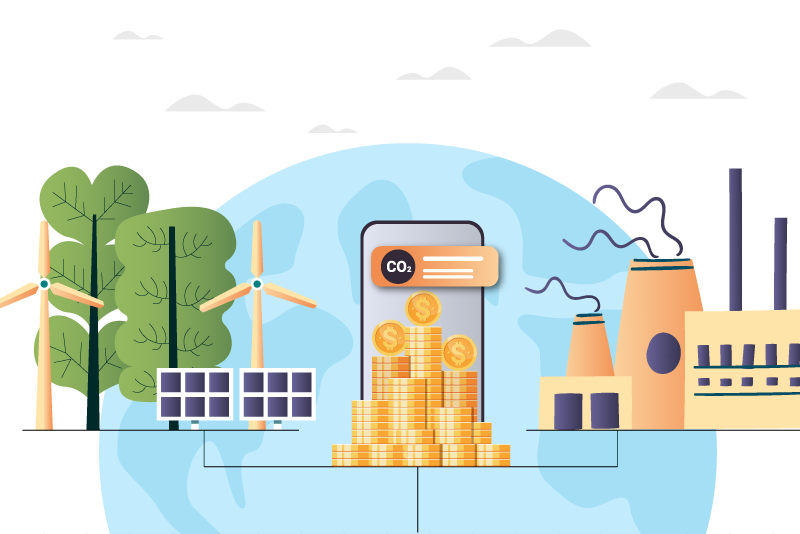Carbon Credits - Overview
Decarbonising economies and reducing emissions are urgently needed. However, the clock is ticking, and the technology is only sometimes available. That's where carbon credits come into the picture. Terms like Carbon Credits, Carbon Footprint, Carbon Trading, Carbon Tax, and Plastic Credits are becoming quite common nowadays.
The Ministry of Environment, Forest & Climate Change (MoEF&CC), in its order, sets out that to achieve and fulfil its COP-26 (Conference of Parties 26) commitment, India is determined to -
(i) meet 50 per cent of its energy needs from renewable energy by 2030;
(ii) reach 500GW non-fossil energy capacity by 2030;
(iii) decrease total projected carbon emissions by one billion tonnes by 2030;
(iv) reduce carbon intensity of the economy by 45% by 2030, over 2005 levels; and
(v) accomplish the target of net zero emissions by 2070.
As a matter of fact, carbon credits can help in achieving many of these goals. Here are the details.

What are Carbon Offset and Carbon Credit?
One Carbon Offset or Carbon Credit represents one metric tonne of carbon dioxide (CO2) that has either been recycled or removed from the atmosphere. While Carbon Credits usually represent the reduction in greenhouse gas emissions, Carbon Offsets, on the other hand, represent greenhouse gas removal via recycling and other similar activities.
The Government of India (GoI) allows each industry to emit some CO2 or other greenhouse gases into the atmosphere. The organisation that achieves to emit such gases in the limits lesser than the allowed threshold gets Carbon Credit Certificates. Conversely, the organisation that releases greenhouse gases over the permitted threshold either has to buy Carbon Credits from the organisations that have been issued these certificates – thereby offsetting their excess emissions, or is imposed with penalties by the Government.
The credits set out in this certificate indicate the quantity of carbon and other greenhouse gases so reduced/removed and which, in turn, are computed via advanced remote sensing data and other AI created over the years.
Significance of Carbon Credits
To create a sustainable environment, carbon was recognised as a tradable good at the United Nations (UN) Kyoto Protocol in 1997 and then again in 2005. This was also echoed and further emphasised in the Paris Climate Agreement in 2015. As per these agreements, a country can transfer and sell the excess capacity of Carbon Credits collected by it to other nations/organisations/institutions that lack enough Carbon Credits to meet its climate targets. The Carbon Trade Certificate motivates nations and businesses to spend on environmentally friendly activities and initiatives.
Who regulates Carbon Credits?
The Energy Conservation (Amendment) Act 2022 has empowered the Central Government, the Ministry of Power, to regulate and formulate the Carbon Trading Scheme and issue Carbon Credit Certificates. Under Section 14AA of this Act, the Government can issue or authorise an agency to issue these certificates to the registered units compliant with such Scheme.
Carbon Trading Scheme
- The Bureau of Energy Efficiency (BEE), an agency set up by the Ministry of Power to make aware and disseminate information on energy efficiency and conservation and also help frame policies and strategies towards that end, has introduced the Carbon Credit Trading Scheme to address the problem of greenhouse gas (GHG) emissions and mitigation of climate change in India.
- The agency has appealed to all stakeholders to actively partake and offer unwavering support for the successful implementation of the Scheme.
- According to BEE authorities, the Scheme aims to facilitate the trading of carbon credits and incentivise and reward units that remove, reduce, or avoid greenhouse gas emissions.
- The Carbon Credit Trading Scheme implementation underscores the urgent need to combat climate change and recognise the pivotal role of market-based mechanisms in achieving emission reduction targets.
- The Scheme assigns a value, known as a carbon credit, to each tonne of carbon dioxide equivalent (tCO2e) avoided or reduced. These credits can be sold, purchased and traded within India’s carbon market framework.
Sectors that need Carbon Credits
The following sectors need Carbon Credits -
- Agriculture
- Chemical
- Pharmaceutical
- Aviation
- Consumer goods
- Automobile
- Plastic industry
Who issues Carbon Credits?
The carbon credits system was officially formalised in the Kyoto Protocol. However, the mechanisms that regulate the Carbon Credits market were framed in the Marrakesh Accords.
To whom are carbon credit certificates sold?
The Carbon Credit Certificates can be sold to the following -
- the GoI to fulfil its commitments;
- the organizations that release more levels of carbon than authorized, and
- other countries that need help to meet their obligations.
However, there needs to be more clarity on the authority that will issue Carbon Trading Certificates.

Salient features of Carbon Credits
- The Government intends to create the Indian Carbon Market (ICM), where a national system will be set up to decarbonise the Indian economy. This will be done by pricing the Green House Gas (GHG) emission via trading the Carbon Credit Certificates.
- The carbon credit is half of a so-called cap-and-trade program. Firms that pollute the environment are given credits that permit them to continue to pollute up to a specific limit, which is reduced periodically. Meanwhile, the company can sell any unneeded credits to another company that needs them.
- If a country emits less than its target hydrocarbons amount, it could sell its surplus credits to nations that still need to achieve its Kyoto-level goals via an Emissions Reduction Purchase Agreement (ERPA).
- The separate Clean Development Mechanism (CDM) for developing nations issued Certified Emission Reduction (CER) carbon credits. A developing country can receive these credits for supporting sustainable development initiatives. The trading of CERs takes place in a separate market.
- At the Glasgow COP26 climate change summit held in November 2021, negotiators approved to set up a global carbon credit offset trading market.

Benefits of Carbon Credits
The following documents are required to obtain SPCB NOC -
- Carbon credits have many advantages for countries, the environment and businesses.
- Selling carbon credits aids the environment and removes carbon from the atmosphere with the help of planting trees or avoiding emissions from other sources, such as switching to clean energy.
- Organisations, businesses and nations that manage to reduce their carbon footprint have encouraged their economies by using the funds they save to invest in sustainable activities.
- Businesses also benefit from purchasing carbon credits for their brand image.
Frequently Asked Questions
-
1. What is the price of Carbon Credit?
India doesn't ascertain any explicit price to a carbon credit. It depends on external factors like fuel cost, tax levy, emission trading scheme, excise duty, international demand, project quality and supply of carbon etc. These factors determine the value of each carbon credit.
-
2. What is Carbon Trading?
Carbon trading is done via a decentralised market where global private parties can exchange Carbon Credit Certificates. Once such a credit is bought and an offset against carbon emission is given, that credit is "retired" and cannot be used or sold again.
-
3. What is the Paris Agreement?
Also popular as the Paris Climate Accord, the Paris Agreement is an agreement among the leaders of more than 180 nations to lower greenhouse gas emissions & limit the global temperature increase to below 2 degrees Celsius (36 degrees Fahrenheit) above pre-industrial levels by the year 2100.
-
4. What is the role of the Kyoto Protocol?
The Kyoto Protocol frames the quotas of greenhouse gases (denominated in individual units) that each developed nation can release. These so-called Assigned Amount Units (AAUs) correspond to an allowance to release one metric tonne of CO2 or equivalent greenhouse gas. Each country then divides its quotas, assigning them to local businesses and organisations and setting a limit on the CO2 emissions for each.
-
5. How to sell Carbon Credits?
Selling the carbon credits is easy. There are three ways to sell your carbon credits.
- i. Selling to offsetting organisations - The first way to sell carbon offsets is to contact specialised firms developing carbon credits.
- ii. Direct carbon credit selling - Another way to sell carbon credits is by contacting emitters who intend to buy the offsets directly.
- iii. Selling carbon credits for brokers - The third way is to find brokers in the carbon trading market. Brokers in carbon markets can take a buyer's quote and find an appropriate offset on the market.

